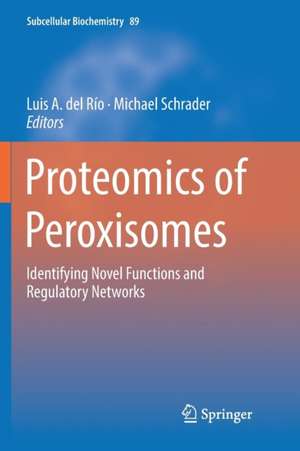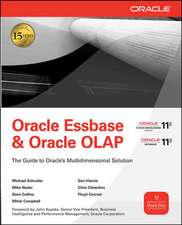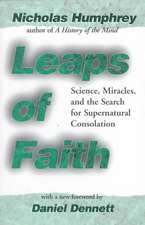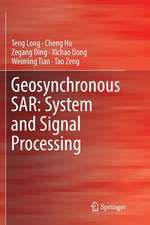Proteomics of Peroxisomes: Identifying Novel Functions and Regulatory Networks: Subcellular Biochemistry, cartea 89
Editat de Luis A. del Río, Michael Schraderen Limba Engleză Paperback – 23 dec 2018
The development of sensitive proteomics and mass spectrometry technologies, combined with bioinformatics approaches now allow the identification of low-abundance and transient peroxisomal proteins and permits to identify the complete proteome of peroxisomes, with the consequent increase of our knowledge of the metabolic and regulatory networks of these important cellular organelles. The book lines-up with these developments and is organized in four sections including: (i) mass spectrometry-based organelle proteomics; (ii) prediction of peroxisomal proteomes; (iii) analysis of peroxisome proteome interaction networks; and (iv) peroxisomes in relation to other subcellular compartments.
The editor Luis A. del Río is Professor ad honorem of the Spanish National Research Council (CSIC) in the Group of Antioxidants, Free Radicals and Nitric Oxide in Biotechnology, Food and Agriculture, Department of Biochemistry and Cell & Molecular Biology of Plants, at the Estación Experimental del Zaidín, Granada, Spain. Del Río’s research group focuses on the metabolism of reactive oxygen species (ROS), reactive nitrogen species (RNS) and antioxidants in plant peroxisomes, and the ROS- and RNS-dependent role of peroxisomes in plant cell signalling.
The editor Michael Schrader is Professor of Cell Biology & Cytopathology in the Department of Biosciences at the University of Exeter, UK. Using mammalian peroxisomes as model organelles, Prof. Schrader and his team aim to unravel the molecular machinery and signalling pathways that mediate and regulate the formation, dynamics and abundance of these medically relevant cellular compartments.
| Toate formatele și edițiile | Preț | Express |
|---|---|---|
| Paperback (1) | 1553.46 lei 6-8 săpt. | |
| Springer Nature Singapore – 23 dec 2018 | 1553.46 lei 6-8 săpt. | |
| Hardback (1) | 1559.80 lei 6-8 săpt. | |
| Springer Nature Singapore – 9 noi 2018 | 1559.80 lei 6-8 săpt. |
Din seria Subcellular Biochemistry
- 18%
 Preț: 948.79 lei
Preț: 948.79 lei - 5%
 Preț: 1456.88 lei
Preț: 1456.88 lei - 18%
 Preț: 1373.84 lei
Preț: 1373.84 lei - 18%
 Preț: 1243.78 lei
Preț: 1243.78 lei - 18%
 Preț: 2098.81 lei
Preț: 2098.81 lei - 18%
 Preț: 1122.10 lei
Preț: 1122.10 lei - 5%
 Preț: 1160.63 lei
Preț: 1160.63 lei - 18%
 Preț: 1396.26 lei
Preț: 1396.26 lei - 18%
 Preț: 1114.96 lei
Preț: 1114.96 lei - 18%
 Preț: 1224.68 lei
Preț: 1224.68 lei - 18%
 Preț: 951.29 lei
Preț: 951.29 lei - 18%
 Preț: 1227.99 lei
Preț: 1227.99 lei -
 Preț: 398.15 lei
Preț: 398.15 lei -
 Preț: 399.88 lei
Preț: 399.88 lei - 18%
 Preț: 1231.47 lei
Preț: 1231.47 lei - 18%
 Preț: 1230.35 lei
Preț: 1230.35 lei -
 Preț: 392.60 lei
Preț: 392.60 lei - 18%
 Preț: 1231.47 lei
Preț: 1231.47 lei - 15%
 Preț: 638.76 lei
Preț: 638.76 lei - 5%
 Preț: 656.26 lei
Preț: 656.26 lei -
 Preț: 389.49 lei
Preț: 389.49 lei - 5%
 Preț: 659.19 lei
Preț: 659.19 lei -
 Preț: 392.37 lei
Preț: 392.37 lei - 5%
 Preț: 662.09 lei
Preț: 662.09 lei -
 Preț: 395.09 lei
Preț: 395.09 lei - 5%
 Preț: 667.99 lei
Preț: 667.99 lei -
 Preț: 400.47 lei
Preț: 400.47 lei - 18%
 Preț: 1224.54 lei
Preț: 1224.54 lei - 15%
 Preț: 647.73 lei
Preț: 647.73 lei - 15%
 Preț: 646.75 lei
Preț: 646.75 lei - 5%
 Preț: 662.30 lei
Preț: 662.30 lei -
 Preț: 395.25 lei
Preț: 395.25 lei - 18%
 Preț: 1230.21 lei
Preț: 1230.21 lei - 18%
 Preț: 1231.95 lei
Preț: 1231.95 lei - 18%
 Preț: 964.54 lei
Preț: 964.54 lei
Preț: 1553.46 lei
Preț vechi: 1894.47 lei
-18% Nou
Puncte Express: 2330
Preț estimativ în valută:
297.27€ • 312.58$ • 245.62£
297.27€ • 312.58$ • 245.62£
Carte tipărită la comandă
Livrare economică 16-30 aprilie
Preluare comenzi: 021 569.72.76
Specificații
ISBN-13: 9789811347535
ISBN-10: 9811347530
Pagini: 508
Ilustrații: XIII, 493 p. 55 illus., 49 illus. in color.
Dimensiuni: 155 x 235 x 26 mm
Greutate: 0.7 kg
Ediția:Softcover reprint of the original 1st ed. 2018
Editura: Springer Nature Singapore
Colecția Springer
Seria Subcellular Biochemistry
Locul publicării:Singapore, Singapore
ISBN-10: 9811347530
Pagini: 508
Ilustrații: XIII, 493 p. 55 illus., 49 illus. in color.
Dimensiuni: 155 x 235 x 26 mm
Greutate: 0.7 kg
Ediția:Softcover reprint of the original 1st ed. 2018
Editura: Springer Nature Singapore
Colecția Springer
Seria Subcellular Biochemistry
Locul publicării:Singapore, Singapore
Cuprins
The proteome of plant peroxisomes.- Defining the mammalian peroxisomal proteome.- Fungal peroxisomes proteomics.- The craft of peroxisome purification – a technical survey through the decades.- Prediction of peroxisomal matrix proteins in plants.- The obvious and the hidden: Prediction and function of fungal peroxisomal matrix proteins.- Predicting peroxisomal targeting signals to elucidate the peroxisomal proteome of mammals.- Multiple localization by functional translational readthrough.- Evolution of the peroxisomal proteome.- Peroxisome protein prediction in Drosophila melanogaster.- Using Pull Down strategies to analyze the interactome of peroxisomal membrane proteins in human cells.- Identification of peroxisomal protein complexes in mammalian cells.- Unraveling of the structure and function of peroxisomal protein import machineries.- The proteome of fruit peroxisomes: Sweet pepper (Capsicum annuum L.) as a model.- Peroxisomes and their central role in metabolic interaction networks in humans.- Characterisation of peroxisomal regulation networks.- Multi-localized proteins: the peroxisome-mitochondria connection Peroxisome-mitochondria inter-relations in plants.- Peroxisomes and cellular oxidant/antioxidant balance: protein redox.- Cell death or survival against oxidative stress.- A role for RNS in the communication of plant peroxisomes with other.
Textul de pe ultima copertă
This new edited volume in the Springer Subcellular Biochemistry Series presents a comprehensive, state-of-the-art overview of the proteomics of peroxisomes derived from mammalian, Drosophila, fungal, and plant origin, andcontains contributions from leading experts in the field.
The development of sensitive proteomics and mass spectrometry technologies, combined with bioinformatics approaches now allow the identification of low-abundance and transient peroxisomal proteins and permits to identify the complete proteome of peroxisomes, with the consequent increase of our knowledge of the metabolic and regulatory networks of these important cellular organelles. The book lines-up with these developments and is organized in four sections including: (i) mass spectrometry-based organelle proteomics; (ii) prediction of peroxisomal proteomes; (iii) analysis of peroxisome proteome interaction networks; and (iv) peroxisomes in relation to other subcellular compartments.
The editor Luis A. del Río is Professor ad honorem of the Spanish National Research Council (CSIC) in the Group of Antioxidants, Free Radicals and Nitric Oxide in Biotechnology, Food and Agriculture, Department of Biochemistry and Cell & Molecular Biology of Plants, at the Estación Experimental del Zaidín, Granada, Spain. Del Río’s research group focuses on the metabolism of reactive oxygen species (ROS), reactive nitrogen species (RNS) and antioxidants in plant peroxisomes, and the ROS- and RNS-dependent role of peroxisomes in plant cell signalling.
The editor Michael Schrader is Professor of Cell Biology & Cytopathology in the Department of Biosciences at the University of Exeter, UK. Using mammalian peroxisomes as model organelles, Prof. Schrader and his team aim to unravel the molecular machinery and signalling pathways that mediate and regulate the formation, dynamics and abundance of these medically relevant cellular compartments.
The development of sensitive proteomics and mass spectrometry technologies, combined with bioinformatics approaches now allow the identification of low-abundance and transient peroxisomal proteins and permits to identify the complete proteome of peroxisomes, with the consequent increase of our knowledge of the metabolic and regulatory networks of these important cellular organelles. The book lines-up with these developments and is organized in four sections including: (i) mass spectrometry-based organelle proteomics; (ii) prediction of peroxisomal proteomes; (iii) analysis of peroxisome proteome interaction networks; and (iv) peroxisomes in relation to other subcellular compartments.
The editor Luis A. del Río is Professor ad honorem of the Spanish National Research Council (CSIC) in the Group of Antioxidants, Free Radicals and Nitric Oxide in Biotechnology, Food and Agriculture, Department of Biochemistry and Cell & Molecular Biology of Plants, at the Estación Experimental del Zaidín, Granada, Spain. Del Río’s research group focuses on the metabolism of reactive oxygen species (ROS), reactive nitrogen species (RNS) and antioxidants in plant peroxisomes, and the ROS- and RNS-dependent role of peroxisomes in plant cell signalling.
The editor Michael Schrader is Professor of Cell Biology & Cytopathology in the Department of Biosciences at the University of Exeter, UK. Using mammalian peroxisomes as model organelles, Prof. Schrader and his team aim to unravel the molecular machinery and signalling pathways that mediate and regulate the formation, dynamics and abundance of these medically relevant cellular compartments.
Caracteristici
Provides a comprehensive, state-of-the-art overview of proteomic analysis of peroxisomes - a field that has seen many recent developments Incorporates a wealth of research on the latest proteomics of peroxisomes derived from mammalian, Drosophila, fungal, and plant origin Presents contributions from leading experts in the field








